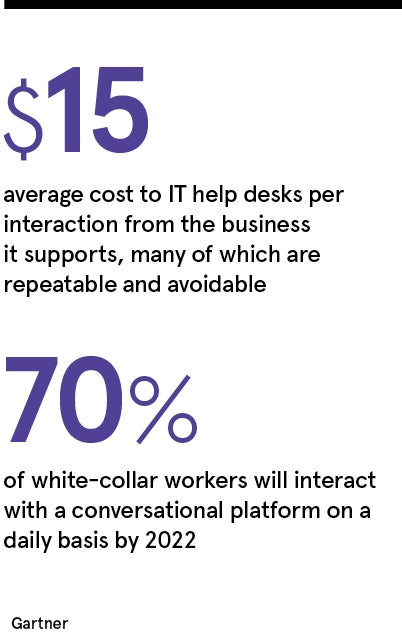Mainly used for improving customer service, virtual assistants now have the potential to transform how organisations work internally. Remote working is fuelling their use. The blended workforce, where humans and bots work together, could eventually outperform those that don’t deploy them.
“The current crisis has made many realise they need to access their work resources from anywhere, easily and intelligently, as if they were searching on Google, whether it’s a holiday form from human resources or a pricing sheet from finance. These requests were easier when everyone was in the office. Now these tasks can be fully automated and delivered remotely,” says Angus Gregory, chief executive of Biomni, a UK company that’s been at the forefront of software development for 20 years.
“Employees now want to search corporate content and share knowledge instantly with colleagues to boost productivity. Yet endless portals and static documents are difficult to navigate. Increasingly workers want to be able to self-serve, self-help and make their own choices at work, like they do in their digitalised personal lives, with browsing for services on Amazon or chatting on WhatsApp. A virtual employee assistant can now answer this need.”

The workplace has changed radically over the last five years and by 2022 more than 70 per cent of white-collar workers will interact with conversational platforms, according to Gartner. “This research was done before the coronavirus pandemic hit. I suspect this threshold has already been reached,” says Gregory.
Gartner’s 2019 CIO Survey also proclaimed that chief information officers believe chatbots are one of the most significant artificial intelligence-based applications to be used by enterprises. One of the key reasons for deploying a chatbot internally is cost. If you call an IT help desk, for instance, the average cost is £12 per interaction, according to Gartner, yet many requests are repetitive and avoidable.
It’s not just IT, as contacting a real person in HR or finance also sucks up valuable company time and resources. That’s because in many organisations knowledge exists in islands and is dispersed. Finding information is not always easy.
“Deploying a virtual assistant can be one answer. It makes sense for organisations to leverage and unlock their internal resources, as well as hidden knowledge. It’s their number-one resource after talent. Chatbots can build intelligence into these processes, levelling the information asymmetrically within a corporation so everyone benefits,” says Gregory, whose company delivers IT solutions for T-Systems, Cognizant and Fidelity Investments among others.
“Recently, natural-language processing has improved tremendously, which means bots can make sense of employee searches very efficiently now, even understanding human sentiment. Unstructured data can also be referenced into bite-sized chunks so it’s searchable, while artificial intelligence and other cognitive services can learn from how employees use the bot and answer requests more efficiently.”
This comes at a time when organisations are seeing the rise of a new persona in the workplace: the business consumer. This is an employee who wants to be as productive as possible, uses whichever platform is fastest at getting the job done. They don’t want to be bogged down by corporate processes and have a nomadic existence when it comes to working habits. This group is able to be as effective in the office, on a train or at home and they are thriving in the current climate.
“Business consumers tend to make consumer-like choices when it comes to navigating internal systems, the intranet and computing environment they operate in for work. They are very conscious of using their own initiative and have a willingness to help others. This persona find chatbots incredibly useful, but more importantly they’re looking for virtual assistance more than anything else,” says Gregory.
To date, some big organisations and multinational companies around the globe have already built internal virtual assistants. These have been at great cost in terms of developer time and effort. There are also bot services where the licensing can be expensive or there’s a need to invest significant resources to set up and maintain the chatbot over time. Big tech players are in on the act too.
“We want to make virtual assistants easy to use and accessible for all organisations; these could be much smaller businesses, public organisations, even schools. It shouldn’t be as difficult as some vendors make it out to be. Virtual assistants should also bring about immediate gain, with no pain, when it comes to setting them up. This is why we developed Tenjin,” says Gregory.
“A virtual assistant used effectively within a business can empower staff. An effective virtual assistant can also offer up precise answers to common questions and bring up any resources instantly, 24/7, 365 days of the year; the virtual assistant does not rack up an hourly rate. It can also be integrated into other collaborative software from Microsoft Teams to Slack.”
We think it’s a good time to launch a new virtual employee assistant that’s affordable and easy to use
The COVID-19 crisis saw the office environment evaporate and the seizing up of support by phone as workforces dispersed. But it also saw the need to maintain internal communications within an organisation and how important that two-way dialogue is to maintain morale.
“The pandemic has made organisations realise they too need to interact with employees. Virtual assistant technology can initiate this, share policy changes when remote working, promote wellbeing and mental health with push notifications. COVID-19 has changed the paradigm for virtual assistants. Business leaders must prepare now for this shift as it becomes mainstream. A lot has changed recently,” says Gregory.
“We think it’s a good time to launch a new virtual employee assistant that’s affordable and easy to use. With Tenjin, we’ve masked all the back-end complexity so businesses can just plug and play, creating a chatbot within minutes. It’s all about improving the flow of information within an organisation. If it makes workers happier, more productive and more empowered, that can only be a good thing.”
To find out more about Tenjin and remote working please go to biomni.com

